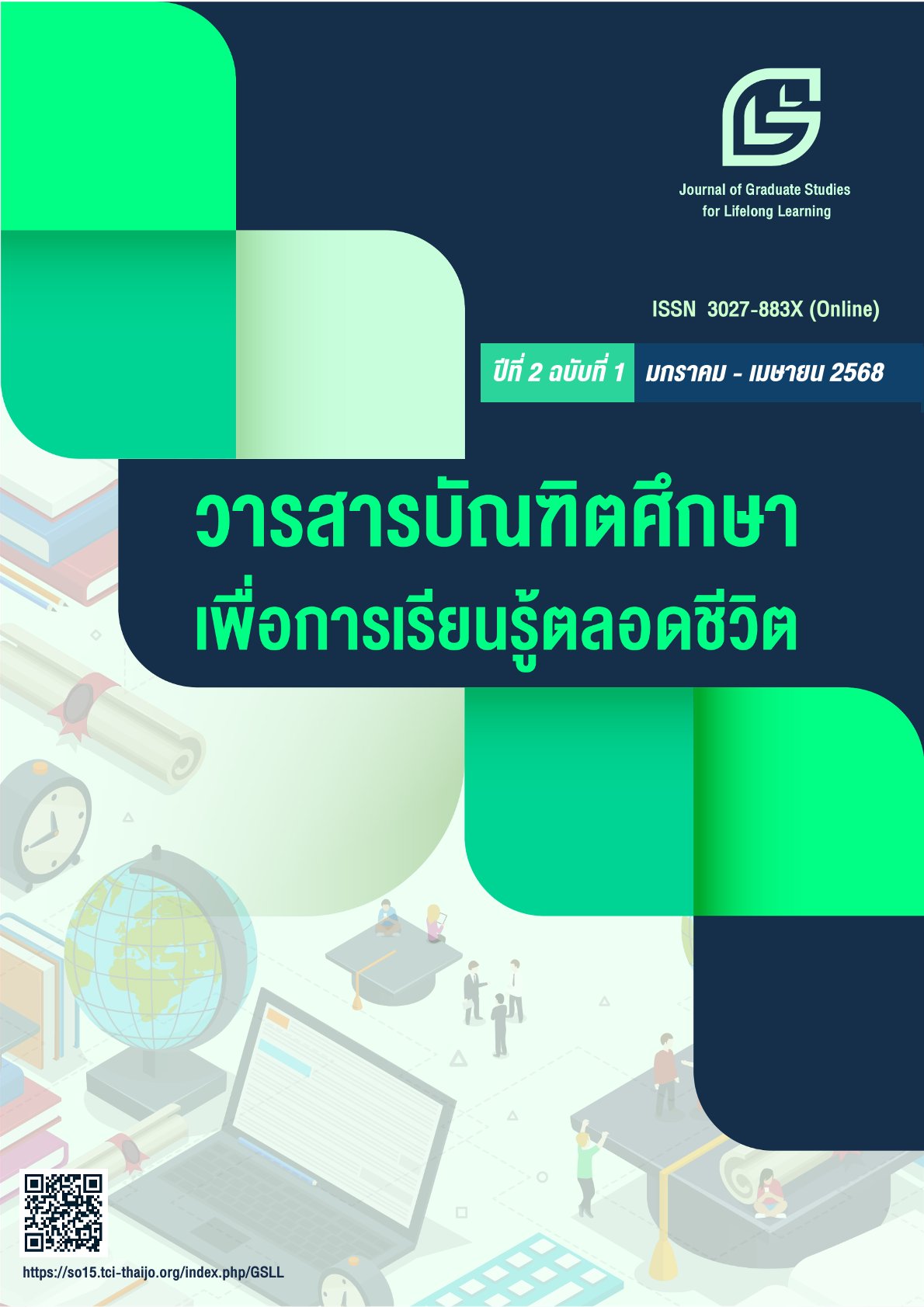The Relationship Between Organizational Atmosphere and Learning Organization of Educational Institutions Under Sukhothai Primary Educational Service Area Office 2
Main Article Content
Abstract
The purposes of this research were to 1) study the organizational atmosphere of educational institutions, 2) study the learning organization of educational institutions, and 3) study the relationship between organizational atmosphere and learning organization of educational institutions under Sukhothai primary educational service area office 2. The sample group was 306 school administrators and teachers in the academic year 2024 under Sukhothai primary educational service area office 2. The sample group was 306 samples, consisting of 28 school administrators and 278 teachers. The samples were determined according to the Krejcie and Morgan tables and the samples were obtained by using the unified campus stratified random sampling. Research instruments is a questionnaire about organizational atmosphere and learning organization of educational institutions under Sukhothai primary educational service area office 2. There are a total of 54 items, which are designed on a Boonchom Srisa-ard scale with approximately 5 levels. The statistics used to analyze the data were frequency, percentage, mean, standard deviation, and Pearson’s product moment correlation analysis The research results were as follows: 1) Organizational atmosphere of educational institutions under Sukhothai primary educational service area office 2 as a whole was at a high level. Considering in each aspect, it was found that the aspect with the highest mean was the warmth and support, followed by the internal communication within the organization and the participation in decision-making had the lowest. 2) Learning organization of educational institutions under Sukhothai primary educational service area office 2 as a whole was at a high level. Considering in each aspect, it was found that the aspect with the highest mean was being a learning person, followed by the technology to support learning and the collaborative learning as a team had the lowest. 3) The relationship between organizational atmosphere and learning organization of educational institutions under Sukhothai primary educational service area office 2 overall and each aspect had a positive relationship at high level of correlation (r). =.900***) with statistical significance at the .01 level.
Article Details

This work is licensed under a Creative Commons Attribution-NonCommercial-NoDerivatives 4.0 International License.
References
กระทรวงศึกษาธิการ, สำนักงานปลัดกระทรวง, สถาบันพัฒนาครู คณาจารย์และบุคลากรทางการศึกษา. (2557). รายงานการศึกษาแนวโน้มการพัฒนาคุณภาพครูเพื่อพัฒนาคุณภาพการศึกษาสู่ศตวรรษที่ 21 (ฉบับย่อ). สถาบันพัฒนาครู คณาจารย์และบุคลากรทางการศึกษา.
กระทรวงศึกษาธิการ, สำนักงานเลขาธิการสภาการศึกษา. (2560). แผนการศึกษาแห่งชาติ ศ. 2560 - 2579. พริกหวานกราฟฟิค.
ชัยพร วิชชาวุธ. (2560). การศึกษาบรรยากาศองค์การในโรงเรียน. มหาวิทยาลัยสุโขทัยธรรมาธิราช.
ชูศรี วงศ์รัตนะ. (2553). เทคนิคการใช้สถิติเพื่อการวิจัย (พิมพ์ครั้งที่ 12). ไทเนรมิตกิจ อินเตอร์ โปรเกรสซิฟ.
ธีระ รุญเจริญ. (2557). ความเป็นมืออาชีพในการจัดและบริหารการศึกษายุคปฏิรูปการศึกษา (ฉบับปรับปรุง) เพื่อปฏิรูปรอบ 2 และประเมินภายนอกรอบ 3 (พิมพ์ครั้งที่ 6). ข้าวฟ่าง.
นันดา ชูประกอบ. (2562). บรรยากาศองค์การและความพึงพอใจในการทำงาน. มหาวิทยาลัยธรรมศาสตร์.
บุญชม ศรีสะอาด. (2560). การวิจัยเบื้องต้น (พิมพ์ครั้งที่ 10). สุวีริยาสาส์น.
ประไพพร สิงหเดช. (2561). การพัฒนาบรรยากาศองค์การในโรงเรียน. มหาวิทยาลัยราชภัฏอุบลราชธานี.
พัณนิดา เถายะบุตร. (2566). บรรยากาศองค์การที่ส่งผลต่อแรงจูงใจในการปฏิบัติงานของครูในโรงเรียน สังกัดสำนักงานเขตพื้นที่การศึกษาประถมศึกษาสกลนคร เขต 2 [วิทยานิพนธ์ปริญญามหาบัณฑิต ไม่ได้ตีพิมพ์]. มหาวิทยาลัยราชภัฏสกลนคร.
พัชชานันท์ โภชฌงค์. (2562). บรรยากาศองค์การกับประสิทธิผลของโรงเรียนสังกัดสำนักงานเขตพื้นที่การศึกษามัธยมศึกษาเขต 3 [วิทยานิพนธ์ปริญญามหาบัณฑิต ตีพิมพ์]. มหาวิทยาลัยศิลปากร.
ภารดี กนิษฐานนท์. (2563). การสร้างบรรยากาศองค์การที่ส่งผลต่อประสิทธิภาพการทำงาน. มหาวิทยาลัยบูรพา.
มงคลชัย พิริยะพานิช. (2556). องค์กรแห่งการเรียนรู้และการจัดการ. ส่องสยาม.
ยุรพร ศุทธรัตน์. (2558). องค์การเพื่อการเรียนรู้ (พิมพ์ครั้งที่ 3). จุฬาลงกรณ์มหาวิทยาลัย.
วรรณา เจริญนาน. (2566). การพัฒนารูปแบบองค์การแห่งการเรียนรู้ของสถานศึกษาขั้นพื้นฐาน [วิทยานิพนธ์ปริญญาดุษฎีบัณฑิต ไม่ได้ตีพิมพ์]. มหาวิทยาลัยศรีนครินทรวิโรฒ.
วรรณา สุนทร. (2553). การสร้างองค์การแห่งการเรียนรู้ในสถานศึกษา. มหาวิทยาลัยราชภัฏสวนสุนันทา.
วิจารณ์ พานิช. (2550). วิถีแห่งองค์กรอัจฉริยะ. จุลสารอุตสาหกรรมสัมพันธ์, 73, 2-3.
วีรยา สัจจะเขตต์. (2564). การพัฒนาแนวทางการเป็นองค์กรแห่งการเรียนรู้ของโรงเรียนขยายโอกาสสังกัดสานักงานเขตพื้นที่การศึกษาประถมศึกษาขอนแก่น เขต 5 [วิทยานิพนธ์ปริญญามหาบัณฑิต ตีพิมพ์]. มหาวิทยาลัยมหาสารคาม.
สถิรพร เชาวน์ชัย. (2560). การวิจัยทางการบริหารการศึกษา. ใน เอกสารประกอบการสอนวิชา 354517 การวิจัยทางการบริหารการศึกษา. มหาวิทยาลัยนเรศวร.
สมชาย วงศ์สุวรรณ. (2564). ปัจจัยที่ส่งผลต่อบรรยากาศองค์การในสถานศึกษาขั้นพื้นฐาน. วารสารศึกษาศาสตร์ มหาวิทยาลัยนเรศวร, 23(3), 112-128.
สำนักงานเลขาธิการสภาการศึกษา. (2560). วิธีวิทยาการประเมินความสำเร็จของการศึกษาเพื่อเสริมสร้างสังคมแห่งการเรียนรู้. พริกหวานกราฟฟิค.
สำนักงานเขตพื้นที่การศึกษาประถมศึกษาสุโขทัย เขต 2. (2566). แผนพัฒนาการศึกษาขั้นพื้นฐาน (พ.ศ. 2566 - 2570) ของสำนักงานเขตพื้นที่การศึกษาประถมศึกษาสุโขทัย เขต 2. สำนักงานเขตพื้นที่การศึกษาประถมศึกษาสุโขทัย เขต 2.
สุธรรม สิกขาจารย์. (2561). การวิเคราะห์ความสัมพันธ์เชิงสาเหตุของวัฒนธรรมองค์การ ภาวะผู้นำ และการจัดการความรู้ที่ส่งผลต่อการเป็นองค์การแห่งการเรียนรู้ของสถานศึกษาขั้นพื้นฐานในภาคใต้ตอนบน [วิทยานิพนธ์ปริญญาดุษฎีบัณฑิต ไม่ได้ตีพิมพ์]. มหาวิทยาลัยรามคำแหง.
อรอนงค์ พันธ์ผูก และคึกฤทธิ์ ศิลาลาย (2567). ความสัมพันธ์ระหว่างภาวะผู้นำการเปลี่ยนแปลงของผู้บริหารสถานศึกษากับความผูกพันต่อองค์กรของครูโรงเรียนในสังกัดสำนักงานเขตพื้นที่การศึกษา. วารสารบริหารการศึกษา มหาวิทยาลัยศรีนครินทรวิโรฒ, 21(41), 134-145.
อภิศักดิ์ ธรรมกุล และภควรรณ ลุนสำโรง. (27, มีนาคม 2564). ความสัมพันธ์ระหว่างบรรยากาศองค์การกับการเป็นองค์การแห่งการเรียนรู้ของสถานศึกษาในสำนักงานเขตพื้นที่การศึกษาประถมศึกษาเลย เขต 2 [Poster presenation]. การประชุมวิชาการระดับชาติ, ชีวิตวิถีใหม่ด้วยงานวิจัยทางสุขภาพและการบริการ, วิทยาลัยนครราชสีมา.
Kelly, J. (1980). Organizational Climate: A Conceptual Perspective. In: A Study to Analyze Organizational Climate of Life Insurance Corporation (3rd ed.). R. D. Irwin.
Litwin, G. H., & Stringer, R. A. (1968). Motivation and Organizational Climate. Harvard University Press.
Marquardt, M. (1996). Building the Learning Organization. McGraw-Hill.
Marquardt, M., & Reynolds, A. (2002). The global learning organization: Gaining competitive advantage through continuous learning. Irwin.
Peter, M. S. (1990). The Fifth Discipline: The Art and Practice of Learning Organizations. Doubleday/ Currency.
Stata, R. (1989). Organizational learning: The key to management innovation. Sloan Management Review, 30(3), 63-74.
Senge, P. (1990). The Fifth Discipline: The Art and Practice of the Learning Organization. Doubleday Currency.
Smith, S. Kimiya-Akhyani, S. Axson, D. Arnautu, A. & Stanimirova, I. (2021). Organizational atmosphere and quality of working life of employees. Thammasat University Press.
Stringer, R. A. (2002). Leadership and organization climate: The cloud chamber effect. Prentice Hall.


